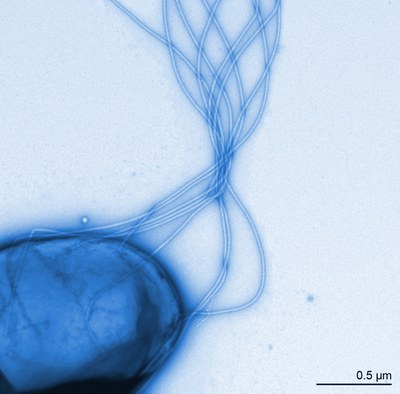Bacteria optimise their swimming behaviour

Elektronenmikroskopische Aufnahme eines Salmonellenbakteriums mit langen Fortsätzen, den Flagellen. Foto: Prof. Dr. Manfred Rhode, Helmholtz-Zentrum für Infektionsforschung, Braunschweig
Bacteria are unicellular organisms that measure just a few micrometres in size. By rotating a propeller-like appendage, the flagellum, they are able to move in liquid environments. This ability to propel themselves is of critical importance for many pathogenic bacteria, such as Salmonella. The motility organelle of the bacteria is a complex, macromolecular structure that comprises thousands of building blocks and measures several micrometres in length.
Interestingly, bacteria can precisely measure the substructures of their flagella on a nanometre scale. In particular, the length of an extracellular joint linking structure – the flagellar hook – is fixed to around 55 nanometres.
To enable this precise length measurement, bacteria use a ‘molecular ruler protein’, which determines the length of the hook structure during the construction of flagella. Why the precisely defined length of the hook structure is important for flagella function, however, was previously unknown.
Researchers at the Humboldt-Universität zu Berlin (HU), together with national and international colleagues from the Helmholtz Centre for Infection Research in Braunschweig, the Braunschweig Integrated Centre of Systems Biology, the University of Edinburgh, the University of Fribourg and Michigan State University, have now determined that the optimal length of the hook structure is critically important for the efficient motility of Salmonella.
As part of this research, the scientists analysed the swimming behaviour of genetically modified bacteria with various hook lengths in different environments and were able to demonstrate that Salmonella can move most efficiently in liquid environments when the hook structure measures around 55 nanometres in length.
These findings are a fascinating example that show why the locomotory organelle of bacteria has developed through the constant process of evolution into the complex, macromolecular structure seen today. The conclusions drawn by the researchers based on the structure of the locomotory organelle with regard to the swimming behaviour of bacteria could also play an important role for the future development of swimming robots at the micrometre scale.
The complete study has been published with the title ‘Hook length of the bacterial flagellum is optimized for maximal stability of the flagellar bundle’ in the scientific journal PLoS Biology.
Prof. Dr. Marc Erhardt
Institute for Biology
Tel.: 030 2093-49780
marc.erhardt@hu-berlin.de
I. Spöring, V.A. Martinez, C. Hotz, J. Schwarz-Linek, K. L. Grady, J. M. Nava-Sedeño, T. Vissers, H. M. Singer, M. Rohde, C. Bourquin, H. Hatzikirou, W. C. K. Poon, Y. S. Dufour, M. Erhardt. (2018) Hook length of the bacterial flagellum is optimized for maximal stability of the flagellar bundle. PLoS Biology 16(9): doi.org/10.1371/journal.pbio.2006989
Media Contact
More Information:
https://www.hu-berlin.deAll latest news from the category: Life Sciences and Chemistry
Articles and reports from the Life Sciences and chemistry area deal with applied and basic research into modern biology, chemistry and human medicine.
Valuable information can be found on a range of life sciences fields including bacteriology, biochemistry, bionics, bioinformatics, biophysics, biotechnology, genetics, geobotany, human biology, marine biology, microbiology, molecular biology, cellular biology, zoology, bioinorganic chemistry, microchemistry and environmental chemistry.
Newest articles

Superradiant atoms could push the boundaries of how precisely time can be measured
Superradiant atoms can help us measure time more precisely than ever. In a new study, researchers from the University of Copenhagen present a new method for measuring the time interval,…

Ion thermoelectric conversion devices for near room temperature
The electrode sheet of the thermoelectric device consists of ionic hydrogel, which is sandwiched between the electrodes to form, and the Prussian blue on the electrode undergoes a redox reaction…

Zap Energy achieves 37-million-degree temperatures in a compact device
New publication reports record electron temperatures for a small-scale, sheared-flow-stabilized Z-pinch fusion device. In the nine decades since humans first produced fusion reactions, only a few fusion technologies have demonstrated…





















